CAMBODIA
Phnom-Penh

Phnom-Penh
Phnom-Penh
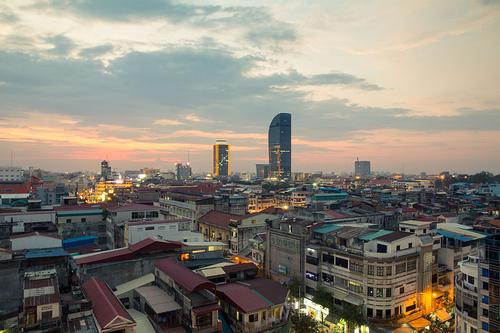 Phnom-PenhPhoto: Dmitry A. Mottl CC 4.0 International no changes made
Phnom-PenhPhoto: Dmitry A. Mottl CC 4.0 International no changes made
Phnom Penh is Cambodia's capital and its largest city. It has been the national capital since the French colonization of Cambodia. The city is located on the banks of the Mekong River. Phnom Penh has developed into Cambodia's political, economic, cultural and diplomatic center. Phnom Penh is one of the most beautiful cities of French origin in Indochina and is also known as the "Pearl of Asia". The city is one of the most important tourist destinations in Cambodia. According to the 2012 census, Phnom Penh has 2,301,725 inhabitants. Phnom Penh is divided into 12 districts. The highest point in the city is less than 12 meters above sea level.
| advertisement |
| Hotels Phnom-Penh |
Location
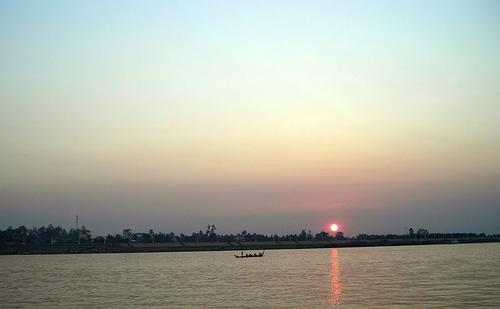 Sunrise over the Mekong at Phnom Penh Photo: Helt CC 3.0 Unported no changes made
Sunrise over the Mekong at Phnom Penh Photo: Helt CC 3.0 Unported no changes made
The coordinates of Phnom Penh are: 11 ° 33 'North latitude and 104 ° 55' East longitude. Phnom Penh is located in the south-central region of Cambodia. The municipality is located on the banks of the Tonle Sap, Mekong and Bassac. These rivers bring fresh water to the city. Phnom Penh and the surrounding areas are exposed to flooding during the rainy season. The total area covers an area of 678.46 square kilometers.
Weather
Phnom Penh has a tropical climate. The weather is warm all year round with only minor variations. The temperature ranges from 22 ° to 35 ° C with the heaviest rainfall from September to October, caused by the tropical monsoons. The southwest monsoon blows inland bringing rain from the Gulf of Thailand and Indian Ocean from May to October. The driest period is in January and February.
The city has two distinct seasons. The rainy season lasts from May to October and has high temperatures accompanied by high humidity. The dry season lasts from November to April, when the temperature can drop to 22 ° C. The best time to visit the city is from November to February, the time with the lower temperatures, lower humidity and less rainfall.
History
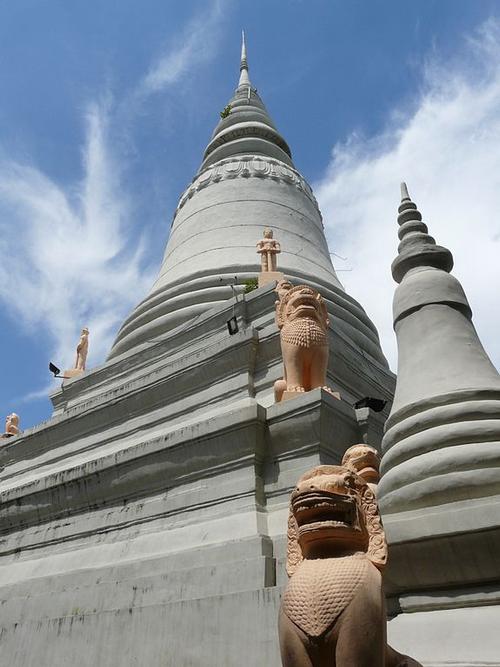 Wat Phnom gives Phnom Penh its namePhoto: Howardhudson CC 3.0 no changes made
Wat Phnom gives Phnom Penh its namePhoto: Howardhudson CC 3.0 no changes made
According to an ancient legend, the settlement was named after a woman named Penh in the late 14th century, when the Khmer capital was still in Anghor, 350 km to the west. The woman is said to be collecting firewood along the river's banks when she saw a floating trunk of a tree in the water. She pulled the trunk out of the water and inside she found four Buddha statues and a statue of Vishnu. It was a sign for the people to move the Khmer capital from Anghor to Phnom Penh. A shrine was built on top of a small hill on the west bank of the Tonle Sap River to house the sacred statues. The shrine is known today as Wat Phnom. In the Khmer language, Phnom means hill.
Phnom Penh remained the royal capital for 73 years from 1432-1505. The city was not used as the capital for 360 years after that due to internal conflicts. The capital was moved to various locations in Cambodia's turbulent history. Phnom Penh became the permanent seat of the government and the capital of Cambodia in 1866.
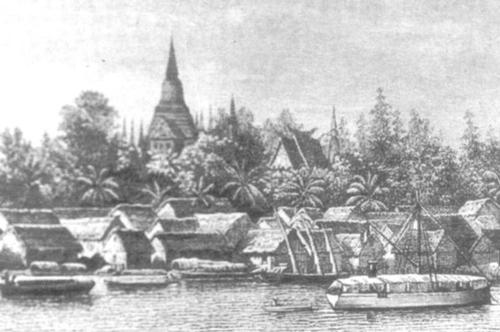 Phnom-Penh in 1887Photo: Public domain
Phnom-Penh in 1887Photo: Public domain
The city's boom began in 1870, when the French colonialists turned it from a village into a city. They built hotels, schools, prisons, banks, courts and offices. Since the 1920s, Phnom Penh has been known as the Pearl of Asia. During the next four decades, Phnom Penh experienced rapid growth.
During the Vietnam War, Cambodia was used as a base by the North Vietnamese army and the Vietcong. Thousands of refugees from all over the country flooded the city to escape the bloody conflict between their own government forces and the Khmer Rouge. The city fell to the Khmer Rouge on April 17, 1975. When the Khmer Rouge was expelled from Phnom Penh by the Vietnamese in 1979, the population began to return to the city. A period of reconstruction began, as a result of new foreign investment and the support of other countries, including France, Australia and Japan.
Sights
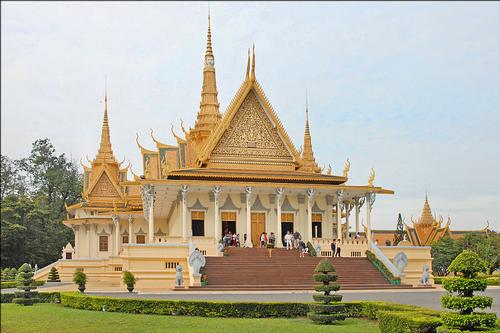 Royal Palace in Phnom PenhPhoto: Jean-Pierre Dalbera CC2.0 Generic no changes made
Royal Palace in Phnom PenhPhoto: Jean-Pierre Dalbera CC2.0 Generic no changes made
Phnom Penh is a city full of sights and memorable places to visit. The most attractive historical monuments are the Royal Palace and the Silver Pagoda. The Royal Palace was used as the residence of the King of Cambodia and is a venue for court ceremonies.
 National Museum Phnom-PenhPhoto: Jean-Pierre Dalbera CC 2.0 Generic no changes made
National Museum Phnom-PenhPhoto: Jean-Pierre Dalbera CC 2.0 Generic no changes made
The National Museum is an inevitable link to the past and houses an invaluable collection of artifacts and historical Khmer antiquities. It was built during the French colonial era in the late 19th century in the classic Khmer style. The oldest structure is Wat Phnom, built in 1373.
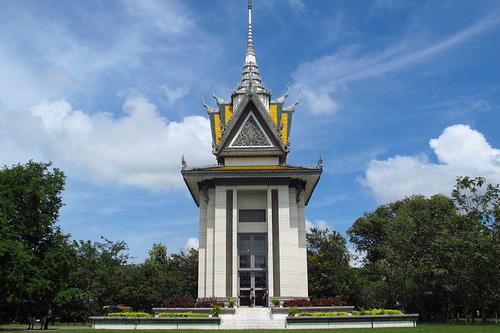 Choeung Ek Genocide Center Phnom-PenhPhoto: Timgray200 CC 3.0 Unported no changes made
Choeung Ek Genocide Center Phnom-PenhPhoto: Timgray200 CC 3.0 Unported no changes made
The Independence Monument dates back to the 1950s and is also built in the old Khmer style. Monuments and memorials for the Khmer Rouge genocide in the 1970s include the Tuol Sleng Genocide Museum (a former high school used as a concentration camp) and the Choeung Ek Genocide Center on the outskirts of the city.
Tips
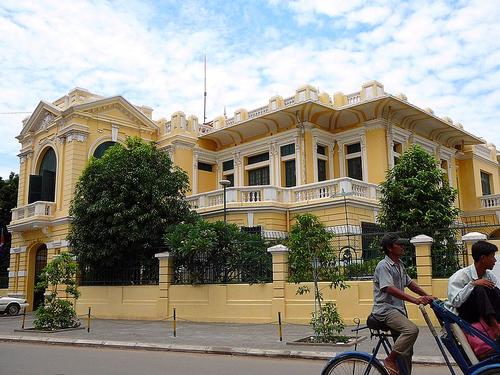 Colonial Villa Phnom-PenhPhoto: Public domain
Colonial Villa Phnom-PenhPhoto: Public domain
The French, who were the colonial masters from the 19th century to the 1940s, leave their mark in various colonial villas, the French churches, boulevards and the Art Deco market Phsar Thom Thmei. A remarkable milestone of the colonial era is the Hotel Le Royal.
Useful links Phnom-Penh
BBC Country ProfilesWorld Fact Book Explore all Countries
How to call
Last updated June 2025
Copyright: Team - The World of Info